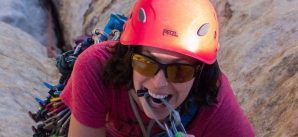|
Getting your Trinity Audio player ready... |
There you are, cruising up the final pitch after a perfect day up in the alpine. The afternoon sun warms your bare arms, and a smile plays on your lips as you savour the effortless flow of the climb. Everything feels right. You move without hesitation, trusting your body to dance up the rock like it has so many times before.
Only this time it doesn’t.
Instead, you find yourself tumbling backwards through empty space, watching the world fly by as your mind tries desperately to grasp what the hell is happening. If you’re lucky, you will walk away with no more than a bruised ego and a tale to tell. But sometimes luck is nowhere to be found and the consequences can leave you forever changed.
I know that heart-sinking feeling all too well, because my luck took a dramatic turn in the fall of 2015. Except it wasn’t a surprise fall that threw a wrench in my day; it was a cancer diagnosis.
At the age of 34, cancer wasn’t even remotely on my radar of possibilities. I was busy living a semi-charmed life in Canmore, Alberta. So when I returned home after a two-month climbing trip, the last thing I expected to hear were the words “You have cancer”.
Difficult questions plagued me: “Am I going to die? What are my treatment options? How bad will it get? Will I still be the same person afterwards?” And most importantly, “Can I still climb??”
Thanks to an army of medical specialists and the support of friends and family, I survived a seven-month blitz of chemotherapy, surgery and radiation. With my doctor’s blessing, I continued to climb throughout my treatment, but I’m no longer the same person I was before cancer. Nor would I want to be.
Without a doubt, cancer is a devastating disease. To this day, it keeps me awake at night in the same way that monsters under my bed kept me awake as a child. However, cancer also granted me an opportunity to become the person I was meant to be. I have met some incredible people since my cancer diagnosis, and have taken the time to contemplate what really matters, and to ask myself who I really am. Best of all, I stumbled upon a way to transform my love of climbing into something more meaningful… something that could enrich the lives of other cancer survivors like me.
The idea first took root at a young adult bootcamp class offered at a cancer support centre in Calgary. I immediately felt at home with this motley crew. I could display my bald head without any pitying looks, and we talked about cancer like it was just another part of this crazy thing called life. Best of all, I didn’t need to explain my situation to anyone. They just understood, because they’d been through it too.
After class one day, a fellow survivor told me that she’d always wanted to learn how to rock-climb. “Would you teach me?” she asked hopefully. In that moment, the two driving forces in my life thus far, climbing and cancer, collided in a powerful way. My heart soared. I wanted nothing more than to share my passion for climbing with other cancer survivors, but first I had to get through treatment.
Lying in bed for days on end, I had plenty of time to think. I began to list all the ways in which cancer was similar to climbing. I felt that if I could somehow correlate the two, then maybe I could convince myself that I have what it takes to get through the worst days.
I realized that cancer and climbing both offer up similar challenges: overcoming physical obstacles, pushing through fears and doubts, and trusting other people with your life. They also provide an opportunity to show up and try your best, even when the outcome is uncertain.
For cancer survivors, uncertainty can be a very real fact of life, and one that I struggle with on a daily basis. Climbers are also familiar with uncertainty, but the relationship is one that we freely enter into. When I climb, I am actively choosing how to face the challenges ahead. Risk and uncertainly become part of the dance that I willingly, even joyfully, engage in.
Eventually it dawned on me that I could choose how to face cancer, in the same way that I can choose how to face a daunting crux. I did not need to be a passive player in my treatment process anymore. This realization brought me tremendous relief when I needed it most, and allowed me to reclaim my life as my own. I began reaching out to other young cancer survivors, and making connections that have since become some of my most cherished friendships.
Fast forward to 2017.
I was officially cancer-free and had starting inviting my new survivor friends out climbing with me, but I wanted to do something more to give back to the survivor community. So I teamed up with Survive & Thrive Cancer Programs, a Calgary-based non-profit that provides adventure expeditions, retreats, films and workshops for young adult cancer survivors.
Together, we launched a monthly indoor-climbing program that allows survivors to connect with one another while discovering am adventurous new sport. We also organized a week-long climbing trip in the Canadian Rockies, where we shared our life stories and encouraged each other to climb to new heights. It was truly amazing to see everyone rise above their challenges and have a great time together in the mountains. We are already planning next summer’s climbing trip, and I can’t wait to meet a whole new crew of cancer-crushers!
Looking back, getting to this point in my life definitely hasn’t been easy, but the most valuable experiences rarely are. I’ve learned that no matter what life throws my way, there are always opportunities to find meaning. These days I smile every time I touch rock, because I know how lucky I am to still be alive, and even luckier to still be climbing!



